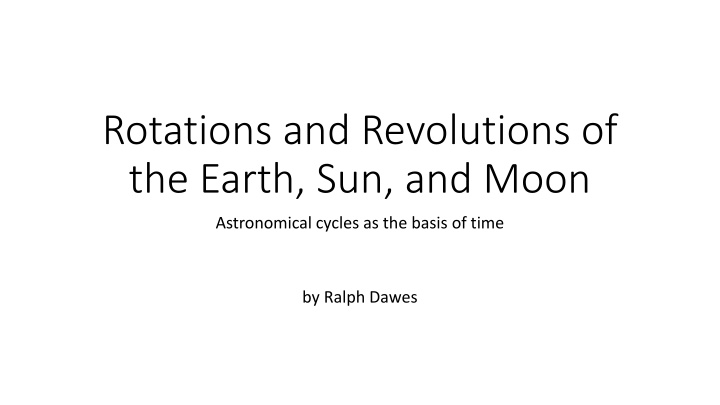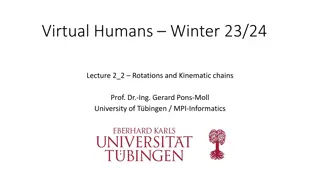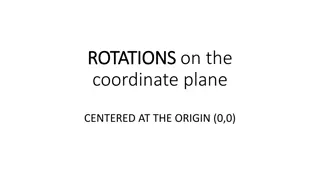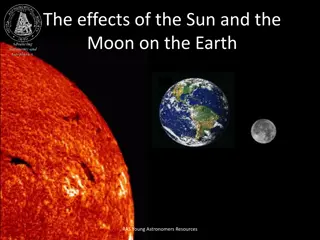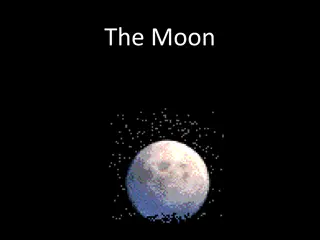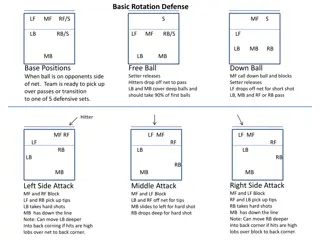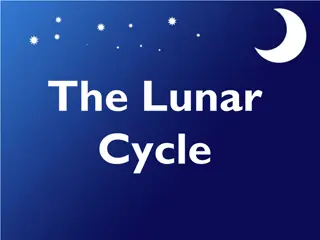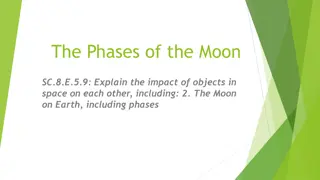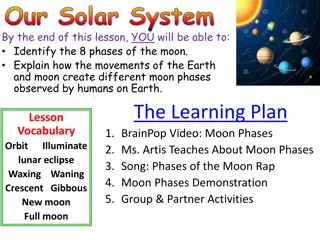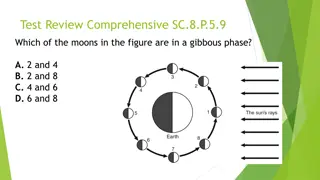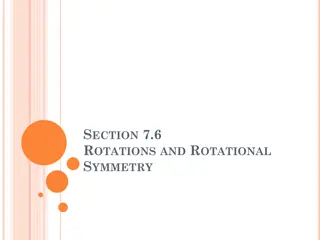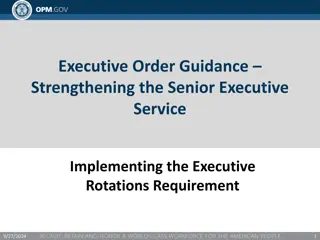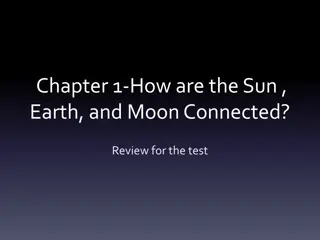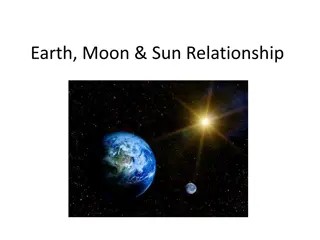The Earth, Sun, and Moon: Rotations and Revolutions Explained
Discover the complexities of time measurement based on astronomical cycles involving the Earth, Sun, and Moon. Learn how the varying lengths of sidereal and solar days relate to the Earth's rotational speed, its elliptical path around the Sun, and the concept of leap years to adjust our calendar system accordingly.
Download Presentation

Please find below an Image/Link to download the presentation.
The content on the website is provided AS IS for your information and personal use only. It may not be sold, licensed, or shared on other websites without obtaining consent from the author.If you encounter any issues during the download, it is possible that the publisher has removed the file from their server.
You are allowed to download the files provided on this website for personal or commercial use, subject to the condition that they are used lawfully. All files are the property of their respective owners.
The content on the website is provided AS IS for your information and personal use only. It may not be sold, licensed, or shared on other websites without obtaining consent from the author.
E N D
Presentation Transcript
Rotations and Revolutions of the Earth, Sun, and Moon Astronomical cycles as the basis of time by Ralph Dawes
How many hours are there in a day? It depends on how you define a day! 1. One 360 rotation of the Earth, which some people think is what a day is, takes 23 hours, 56 minutes, and about 4 seconds. Not 24 hours. a. This 360 rotation, 23 hour 56 minute 4 second day is a sidereal day 2. From solar noon to solar noon (when the Sun gets highest in the sky) takes, on average, 24 hours and a couple of milliseconds a. This 24-hour day is a solar day. b. The extra milliseconds are because the rotation of the Earth has slowed since the length of the day was first measured, over a century ago c. During a solar day, the Earth goes around more than once, goes more than 360 around. Why? See the illustration on the next slide. 3. Days are slowly getting longer, a few small fractions of a second each year a. Days get longer because the Earth rotates slower and slower over time b. Earth is rotating slower and slower a. mainly because it is losing angular momentum in its tidal interactions with the Moon
Why does it take more than one full turn of the Earth to complete a solar day? A solar day is the length of time it takes from solar noon to solar noon, which averages 24 hours. The illustration shows why this is so. Basically, it s because the Earth is going around the Sun, Image copied from a Cornell University astronomy class Web page, at http://www.astro.cornell.edu/academics/courses/astro201/sidereal.htm
Earth takes an elliptical path in revolving around the Sun. This Causes different days, from solar noon to solar noon, to have different lengths. Some days are several minutes shorter or longer than other days, steadily changing back and forth over the course of a year The 24-hour length of time is just the average. And, as noted previously, because the Earth s rotation has slowed a bit since the length of the day was set, the average length of a day, solar noon to solar noon, is a few milliseconds (thousandths of a second) longer than 24 hours.
A year is one revolution of the Earth around the Sun To the nearest hundredth of a day, a year lasts 365.24 days (not 365.25) To take care of the extra nearly quarter day each year, we add an extra day in February, February 29, to every fourth year, which is called a leap year To take care of the fact that it s actually 365.24 days in a year rather than 365.25, every 400 years (on years divisible by 400) we skip a leap year. The last time this happened was the year 2000. Even though it was 4 years after the leap year of 1996 and 4 years before the leap year of 2004, the year 2000 was not a leap year and had no February 29. This won t happen again until the year 2400, if we keep following the Gregorian calendar that long.
The seasons are caused by The rotational axis of the Earth being tilted 23.4 from to the ecliptic plane. Alternatively, you could say the rotational axis of the Earth is oriented 66.6 from the ecliptic plane, rather than 90 . That discrepancy, that 23.4 tilt, is what causes the seasons. In Wenatchee on the first day of summer, the heater of the Earth and air, the Sun, is up for nearly 16 hours. At the same time, its intensity, how powerfully it heats the Earth and air, is more than twice as powerful as in mid-winter. In Wenatchee on the first day of winter, the heater of the Earth and air, the Sun, is up for only about 8 hours. At the same time, its intensity, how powerfully it heats the Earth and air, is less than one half as powerful as in mid-summer. Note: means perpendicular to
The Arctic Circle is a parallel of latitude, encircling the North Pole marking the limit of that zone around the pole where at least once a year the Sun does not set. You could say, therefore, that the Arctic Circle is the boundary of the northern Land of the Midnight Sun. From the Arctic Circle northward, the closer you get to the pole, the more days there are each year when the Sun will not set. Similarly, the Arctic Circle marks the limit of that zone around the pole where at least once a year the Sun does not rise. You could say, therefore, that the Arctic Circle is the boundary of the northern Land of the Noontime Dark. The Arctic Circle is at a latitude of 66.6 N, which is the latitude of the North Pole, 90 N, minus the tilt of the Earth s axis of rotation, 23.4 . This is not a coincidence. The tilt of the Earth s axis of rotation determines the latitude of the Arctic Circle.
The tropics Are that region of the Earth where the Sun reaches the zenith The zenith is the highest point in the sky, directly overhead, 90 up from the horizon, the top center point of the sky. The Sun never gets close to the zenith in Wenatchee, because Wenatchee is at a latitude well outside the tropics. The northern boundary of the tropics is the Tropic of Cancer, a line of latitude that is currently at a latitude of 23.4 N, due to the tilt of Earth s axis of rotation. If Earth s axis of rotation was not tilted at all, then only at the equator itself would the Sun ever reach the zenith. On the day of the summer solstice, the Sun at noon is directly above the Tropic of Cancer (i.e. at the zenith of the sky at that latitude).
The equinoxes Equinoxes and solstices derive from the orientation of the Earth s axis of rotation, the north pole-south pole axis, relative to the direction of the Sun When the polar axis is oriented exactly sideways to the Sun, so that the terminator, the line between day and night, the shadow line, passes right through the poles: that s an equinox Equinox means equal night. Everywhere on Earth that day experiences half a day of daylight, half a day of darkness, so night equals day. The vernal equinox happens in March, usually on March 19 or 20 The vernal equinox is the first day of spring, astronomically defined The autumnal equinox happens in September, typically on September 22 The autumnal equinox is on the astronomically defined first day of fall
The summer solstice When the north pole is oriented as directly in toward the Sun as it gets each year, that s the summer solstice (for the northern hemisphere it is, at any rate) The summer solstice is usually on either June 20 or 21 The summer solstice is on the astronomical first day of summer, by definition For latitudes on Earth going north away from the equator on the summer solstice (and this effect gets stronger the farther away from the equator) The Sun is up longer than it is down, to a maximum amount In other words, the longest day of the year is the day of the summer solstice The Sun reaches its highest point in the sky it will reach that year, at solar noon, on the summer solstice Solstice means Sun coming to a standstill, referring to how the Sun will no longer be standing higher in the sky each day. On the day of the summer solstice the Sun pauses from its climb, and then it starts sinking lower in the sky each day
The winter solstice When the north pole is oriented as directly out away from the Sun as it gets each year, that s the winter solstice (for the northern hemisphere it is, at any rate) The winter solstice is usually on December 21 The day of the winter solstice defines the astronomical first day of winter For latitudes on Earth going north away from the equator on the winter solstice (and this effect gets stronger the farther away from the equator) The Sun is down longer than it is up, to a maximum amount In other words, the shortest day of the year is the day of the winter solstice And, conversely (only so many hours in a day) the longest night of the year is that night The Sun reaches its lowest point in the sky it will reach that year, at solar noon, on the winter solstice Solstice means Sun coming to a standstill, referring to how the Sun stops getting lower in the sky each day. On the day of winter solstice the Sun pauses from its descent, and then it starts climbing higher in the sky each day.
The lunar phases (the phases of the Moon) Are caused by the combination of the following two factors: The fact that the Moon revolves around Earth (approximately once a month) The fact that the bright portion of the Moon we see in the sky is the part that the Sun is shining on The Moon, like the Earth, does not produce its own light, it just reflects Sunlight
The eight phases of the Moon 1. new Moon When the Moon is in the same direction in the sky as the Sun is The dark side of the Moon, the back side, is facing Earth then So we don t see the dark new Moon with our naked eyes, all we can see in that direction is the bright light of the Sun The new Moon lasts, technically speaking, for only an instant of time (you can look up the date and time of each month s new Moon) 2. waxing crescent a crescent-shaped Moon that grows bigger (waxes) day by day east of (to the left of) the Sun lasts about a week
The eight phases of the Moon, contd 3. first quarter when the Moon is in one quarter of the way around from the Sun 90 east of the Sun, 90 to the left of the Sun, in other words we see half the Moon lit up at first quarter first quarter phase lasts, technically speaking, for only an instant of time (you can look up the date and time of each month s first quarter Moon) 4. waxing gibbous more than half a Moon, which gets bigger (waxes) day by day gibbous means humped, bulging, or protruding the waxing gibbous phase lasts about a week
The eight phases of the Moon, contd 5. full Moon when the Moon s lit-up face is facing straight toward the Earth the full Moon rises while the Sun sets the full Moon phase lasts, technically speaking, for only an instant of time (you can look up the date and time of each month s full Moon) at full Moon, the Moon is opposite the Sun in the sky (180 from the Sun) 6. waning gibbous more than half a Moon, which gets smaller (wanes) day by day gibbous means humped, bulging, or protruding the waning gibbous phase lasts about a week
The eight phases of the Moon, contd 7. third quarter when the Moon is in three quarters of the way around from the Sun 90 west of the Sun, 90 to the right of the Sun, in other words we see half the Moon lit up at last quarter last quarter phase lasts, technically speaking, for only an instant of time (you can look up the date and time of each month s last quarter Moon) 8. waning crescent a crescent-shaped Moon that grows smaller (wanes) day by day west of (to the right of) the Sun lasts about a week
The word month comes from the word Moon The average month, going from new Moon to new Moon, is 29.53 days. In our calendar (January, February, etc.), the average month is 30.44 days So calendar months are just rough approximations of a lunar month That is why sometimes a month will have two full Moons, one the first day of the month, the other the last day of the month Note that February can never have two full Moons, it s not a long enough month The 29.53-day month, new Moon to new moon, or full Moon to full Moon if you prefer, determined by the phases of the Moon, is the synodic month The sidereal month, which is how long it takes the Moon to go around the Earth 360 , exactly once, is 27.32 days long
Why the sidereal month and the synodic month are different Why the sidereal month and the synodic month are different It s because, while the Moon goes around Earth, the Earth goes around the Sun. The synodic month is defined in terms of the lunar phases. The lunar phases are determined by how the Moon is lit up by the Sun, as seen from Earth. Because the Earth has moved part way around the Sun, as the days since the last new Moon have gone by, to get the Moon in the same position relative to the Earth and Sun requires that the Moon to goes around the Earth more than 360 , as illustrated. Clear? Image copied from http://pages.uoregon.edu/jimbrau/BrauImNew/Chap01/FG01_22.jpg . Also see Avila Earth at http://avilaearth.weebly.com/earth-sun-and-moon-basics.html . For an animated illustration see http://www.sumanasinc.com/webcontent/animations/content/sidereal.html
A couple more Moon tidbits, just to drive you luny A couple more Moon tidbits, just to drive you luny A synodic month only averages about 29.53 days. Some months are large fractions of a day longer or shorter (though still between 29 and 30 days long), because of that elliptical orbit of the Earth around the Sun. The elliptical orbit has such eccentric effects on days and months! Eclipses don t happen every new Moon (which would be a solar eclipse, the Moon blocking the Sun) and full Moon (which would be a lunar eclipse, the Moon in Earth s shadow) because the orbit of the Moon around the Earth is not in the same plane as the orbit of the Earth around the Sun. The lunar orbit is not in the ecliptic plane, in other words. The two orbital planes intersect along the line of nodes. When the line of nodes is lined up just right at new Moon or full moon, an eclipse will occur.
Some final take-away points: astronomy is the basis of our calendars and our clocks, but Compared to the time-keeping precision we can achieve with modern technology, the astronomical cycles of the Earth, Moon, and Sun are very poor time-keepers. Our distant ancestors did not realize this at first, though they knew a lot, including how the number of days in a year was not exactly 365, and when eclipses would occur, and so on. We base precise measurements of time in our modern world on atomic clocks. We need that high level of precision for such things as the Global Positioning System that you can use to measure exactly where you are. Atomic clock time-keeping is now so precise that we can use it to study and learn more about how planets and moons and satellites move, such as whether or not they are affected by such things as the relativistic effects of gravity, or whether the length of a day on Earth is affected by a big earthquake (it usually is).
